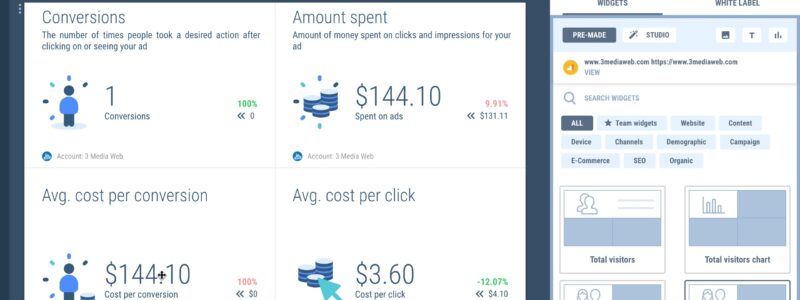
Jeff is a CMO for a major lifestyle and leisure brand. He has a corner office and an Executive Assistant. He has no time for excuses.
There are a lot of C-level execs who think like Jeff: “get to the point… is this working or not?”
If you work in marketing, you’ve probably dealt with a Jeff—either as a boss or a client. They want the answer and they want it now.
And they want data to back it up.
That’s where your social media marketing reports come in. We wrote this guide to help you generate killer SMM reports so you can keep Jeff happy, and prove that you’re crushing it on social.
Like any good how-to blog post and guide, we included some paid affiliate links in this post. We earn a tiny bit of income from sales generated through those links. You know the deal.
Anyway!
Onto the good stuff…
Features
SMM Report Features
What should a good SMM report have in it? There are a million options, but here’s what we think a good SM Marketing report should show, have, or do:
- Automation — Send out reports for you automatically
- Multi-source — Combine stats/data from lots of sources (Google, Facebook, etc)
- Whitelabel — Let you remove the tool’s branding and use your own logo
- Team access — No one works alone. Collaboration is key.
- Custom data — Lets you add data from a non-standard source
- Room to grow — Ability to maintain multiple campaigns at once
Any reporting tool that can do all those things—and generate reports that look good—will get an A+ from us.
Let’s look at an example.
Social Media Marketing Report Example [INFOGRAPHIC]
Let’s take a look at what a professional SMM report looks like. This example comes from a pro tool called Whatagraph.

Phew! That’s a lot of info. Let’s break it down.
Automation
1. Schedule Automated SMM Reports
First things first. Set up daily, weekly, monthly, quarterly, or yearly automated reports to reach your clients email at the time you select.
That way, you only have to do the work once, and the client gets always-current data delivered to them on regular basis.
You’re the hero that makes it happen.
With the right tool for the job, you’ll always know how your automated reports are performing with delivery summaries—a report about your reports.
So meta.
These automated reports don’t have to be TOO in-depth. We’ve had a lot of success automating the high-level stuff, and then following up with a more detailed analysis of the really important numbers.
2 reports may sound like more work, but since the first report is fully automated, we never have to touch it.
No extra work involved.
Data Sources
2. Pull data from multiple sources
Start with one general report to see the high-level performance of all your marketing channels.
After this, we’ll get into some of the finer details, but start with the big picture.
Top-Level SMM Report Metrics
All marketing is goal-driven. And, on some level, all marketing feeds into sales. How exactly your social marketing feeds into your sales pipeline is up to you, of course.
But start with the big stuff.
- How many new customers did you acquire?
- How many new prospects (leads)?
- Which channels drove the most customers and/or prospects?
- Which campaigns was the best performer on each channel?
Compare different landing pages and marketing campaigns. Monitor how different landing pages are performing in terms of visitors, leads, and customers.
Is your Landing Page #1 converting like crazy on Facebook traffic, but falling flat on Twitter traffic?
These reports can tell you that.
Compare the same metric for different data sources to see how different campaigns, content, and/or landing pages are performing.
That’s where the real power lies.
Whitelabel
3. Use your own branding
Customize your reports with your own logo, custom colour schemes and send them from your own domain.
With all a good social media marketing report branding removed, you can take all the credit to yourself.
Whitelabelling is pretty standard among most good tools. Frankly, it usually costs more for a license/subscription that supports whitelabels, but it’s usually worth it.
Jeff—or whomever your client/boss/stakeholder is—probably doesn’t care what tool you use. And most everybody understands that social media reporting (all reporting, really) requires some tools.
You can’t do it alone.
But still, the more cohesive your branding and advising can be, the better. Whitelabelling your SM reports can help.
Collaboration
4. Invite team members
Invite your team members, assign different roles and access to individual clients and their reporting.
Administrator has access to all features, including ability to add new users and access payment options.
Manager has access to account settings, is able to add and delete clients as well as manage team members. Managers cannot access payment options.
Reporter has only access to assigned client and is able to manage and fully customize specific client’s reporting.
Offline Data
5. Include offline data
With a good social media marketing report, you can easily insert your own custom data and visualize it using our infographic reports.
Build a single report to visualize your business performance from customer acquisition to their activation, retention and revenue.
API Integrations
6. Connect all your data sources
A good social media marketing report reports support all the key digital marketing tools and have ready made report templates to simplify your monthly reporting tasks.
Add your website analytics, PPC, SEO, social, call tracking, review and email marketing platforms to get your data gathered automatically for instant visual marketing reports.
With a good social media marketing report, social media analytics reporting is an example when ‘set it and forget it’ simply works. It’s easy to connect social media channels such as Instagram, Twitter, LinkedIn, YouTube and Facebook.
You can also create a report for your AuthorityLabs, CallRail, AdRoll, MailChimp or Google My Business insights.
Monitor and report on your Celtra, Campaign manager and SEMrush performance in one place.
Filtering
Bonus: Filter your campaigns & scope
Reporting periods as flexible as never before. Your single report will hold the data for several campaigns within different date ranges – for extremely flexible marketing campaign reporting.
After all, it’s not always about monthly reports, right?
Walkthrough Video
Take 2 minutes and watch this. You’ll be glad you did.
See what I mean? The SMM reporting tool is really powerful, and the reports it generates are gorgeous.
Report like a Pro
No more excuses. Time to up your game.
Your Jeff—whatever his or her name is—deserves better SMM reports. We all know how important accurate data is to successful marketing, and SMM is especially hard to report on.
- You don’t need to reinvent the wheel.
- You don’t need to lose hours making them the hard way.
You need to try Whatagraph.
You’ll be glad you did. We are—and so are our clients. We made sure to ask every one of our 50+ marketing clients what they thought of their new reports, and they all loved it.
We love Whatagraph, and we know you will too.
In the interest of open transparency, this is just another quick reminder that yes, we’ll earn a small bit of income whenever someone signs up after reading this.

